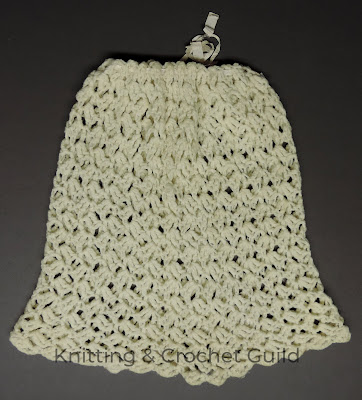I saw a skein of knitting yarn in the Knitting & Crochet Guild collection recently - Little Dorritt 100% Nylon. I remembered that I had also seen a pattern for Little Dorritt wool and nylon sock yarn among all the patterns in the collection, so I brought the two together and tried to do some research on the maker.
 |
| Little Dorritt 100% Nylon and leaflet No. 156 |
The company that published the pattern and manufactured the yarn is named as George Raw Ltd., of Bingley (West Yorkshire), 'Spinners of Top Quality Hand Knitting Yarns", and the address on the pattern leaflet is Harden Beck Mills. The valley of Harden Beck is now a pleasant wooded area of countryside, but at one time there were several textile mills along the valley, originally water powered.
I haven't managed to find out much about George Raw Ltd. The company was certainly at Harden Beck Mills in the later 1930s. Little Dorritt wools were advertised by a shop in Hartlepool in the early 1920s - presumably made by George Raw Ltd., and definitely wool at that point, long before nylon was introduced. Little Dorritt wool and nylon sock yarn was more widely advertised starting in 1953 (when I think the pattern was published), and George Raw Ltd. was still at Bingley in 1958. And then in the 1980s, Little Dorritt yarns were advertised by a completely different company - Sejeant Textiles. with the address Tobits, Werneth Low, Hyde, Cheshire. Then it gets more mysterious: Ravelry lists Little Dorritt 3-ply and 4-ply sock wool, both discontinued. There are several illustrations of the 4-ply, one which is clearly the 1950s George Raw version, with "Little Dorritt" printed on the ball band in the font used on the ball of 100% nylon above, and the others the later Sejeant version. But Ravelry says that they are both King Cole yarns, (though some of the ball bands give the Sejeant name as well/instead). I guess that at some point, Sejeant took over the Little Dorritt name and later still Sejeant started making Little Dorritt for King Cole. All very hard to disentangle.
But the Little Dorritt 100% Nylon is worth looking at. In the early 1950s, nylon for knitting was a revolutionary innovation. It was mothproof, didn't shrink, and washed easily. Pure nylon knitting yarn fell out of favour fairly quickly - it is often not at all nice to knit with, and catches on the minutest irregularity in your fingers. Wool sock yarn with nylon was also introduced in the early 1950s, like the Little Dorritt sock yarn in the pattern leaflet, and sock yarn still usually has a proportion of nylon for durability (75% wool and 25% nylon, commonly).
Little Dorritt 100% nylon actually feels quite woolly, at least in the skein, and it might be quite pleasant to knit with (though I don't propose to try). And although I first thought it was a small skein or hank, it is actually ready wound. (Can you call it a ball when it's that shape? I don't know.)
The yarn advertises its virtues on the back of the ball band:
A Knitting Luxury
"Little Dorritt" 100% Nylon Knitting Wool is made specially for Knitters who prefer something different.
Here is an exquisite 3-ply knitting yarn made from Nylon which is lovely to handle and extremely hard wearing though soft to the touch.
Garments made from this yarn dry quickly after washing, they do not shrink and the colours do not run.
The ball band also refers to the way the yarn is packed:
A NEW & NOVEL PACK THAT CAN BE USED FROM THE HANDBAG OR THE POCKET
NO RAVELLING - NO WASTE, USE FROM OUTSIDE
I'm not sure how keeping it in your pocket and using it from the outside would work - a centre pull ball is more amenable to being used in a yarn holder (or pocket) in my experience, but again, I'm not going to try it with the Little Dorritt yarn - it deserves to be kept as it is.
Although this is a very minor, forgotten byway in the history of knitting yarns, I think it's interesting that so many yarn companies were active in the mid 20th century. They have mostly disappeared, but they evidently survived for some time - Little Dorritt yarns, apparently under the ownership of George Raw Ltd., were in production from the early 1920s (and possibly much earlier) to at least the early 1960s. But small companies had to compete with some very big brands (Patons & Baldwins, Ladyship, Lister and Sirdar, and later Robin, Emu and Wendy, amongst others). The big brands had big advertising budgets and published pattern leaflets prolifically - at least 200 designs a year, in some cases. But the little brands somehow kept going and kept introducing new yarns and new ideas, even if eventually they failed. Well done, George Raw, whoever you were.




%20.JPG)
%20.JPG)
.JPG)
.JPG)
.JPG)
.JPG)
.JPG)


.JPG)
.JPG)
.JPG)


.jpg)



.JPG)
-001.JPG)
-001.JPG)
.JPG)



.JPG)


.JPG)
.JPG)
















